Space Shuttle Mission Chronology: Part 2 – 1995-1998
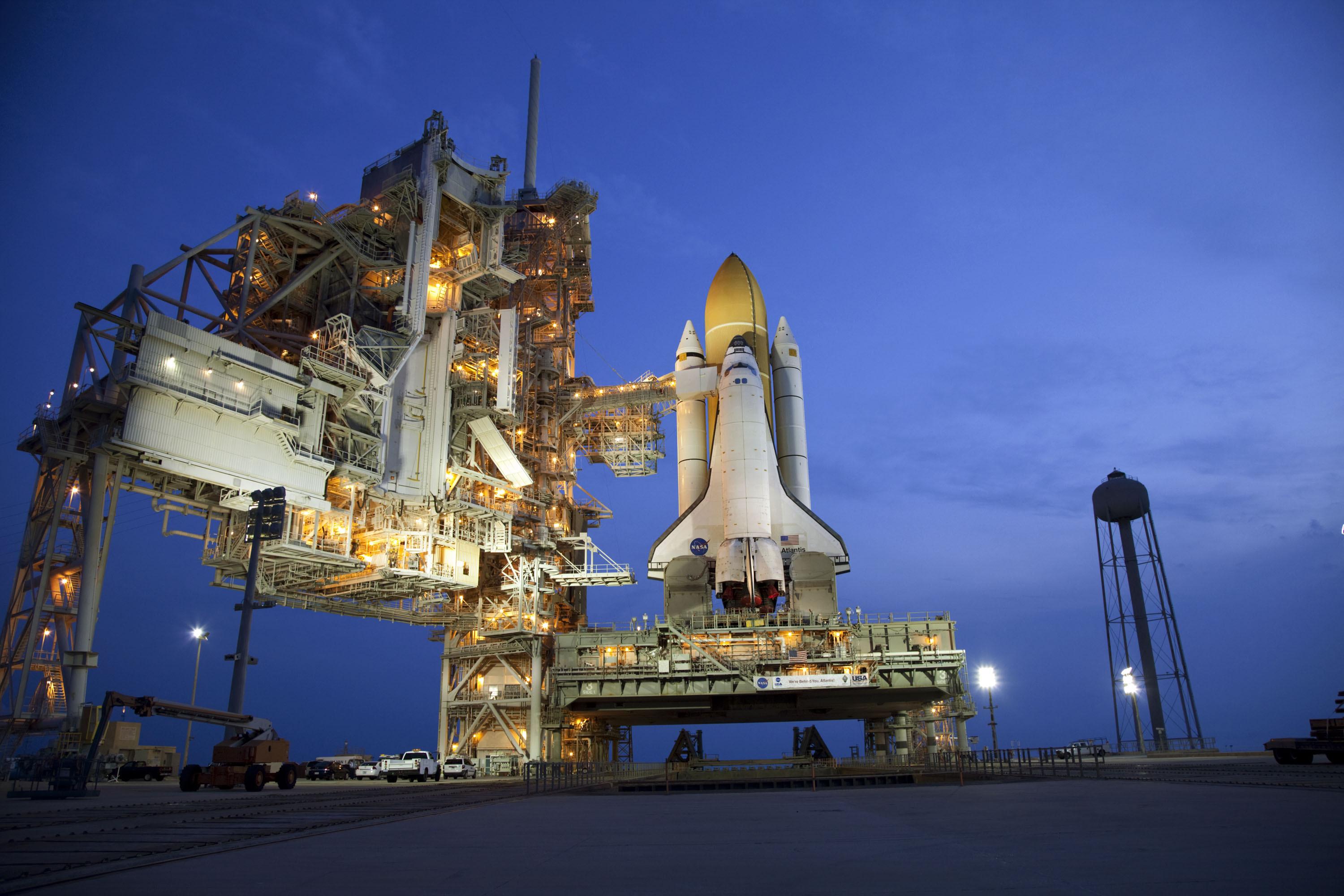
Continued from:
Space Shuttle Mission Chronology: Part 1 — 1999-2011
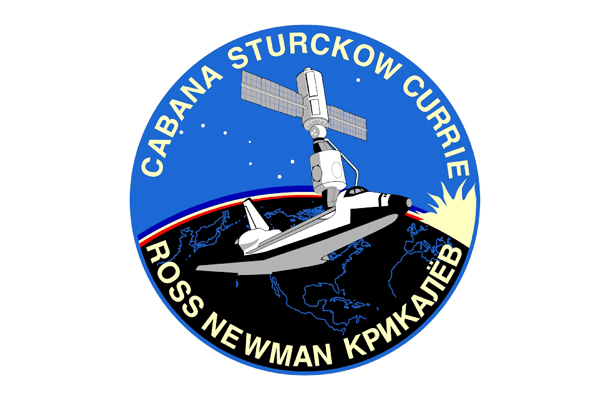
1998
STS-88
Mission: International Space Station Flight 2A
Space Shuttle: Endeavour
Launch Pad: 39A
Launched: Dec. 4, 1998, 2:35 a.m. CST
Launch Window: 5-10 minutes
EVAs: 3 spacewalks
Landing: Dec. 15, 1998, 9:53 p.m. CST
Mission Duration: 11 days, 19 hours, 18 minutes
Orbit Altitude: 208 nautical miles
Orbit Inclination: 51.6 degrees
STS-88, the 13th flight of the Space Shuttle Endeavour, began the largest international cooperative space venture in history as it attached together in orbit the first two modules of the International Space Station. STS-88 was the first human International Space Station assembly flight.
The primary mission objective was to rendezvous with the already launched Zarya Control Module and successfully attach the Unity Node, providing the foundation for future station components.
Crew consisted of Commander Robert D. Cabana, Pilot Frederick W. Sturckow, Mission Specialists Nancy J. Currie, Jerry L. Ross, James H. Newman and Sergei K. Krikalev.
Breaking space news, the latest updates on rocket launches, skywatching events and more!
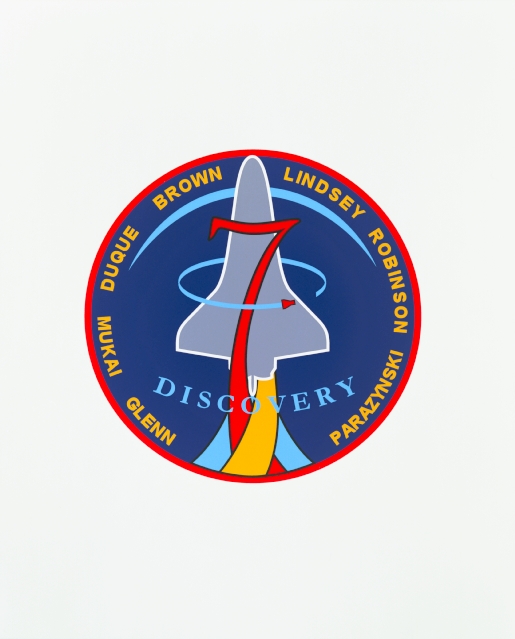
STS-95
Mission: SPARTAN-201; John Glenn Returns to Space
Space Shuttle: Discovery
Launch Pad: 39B
Launched: Oct. 29, 1998, 1:19 p.m. CST
Launch Window: 2.5 hours
Landing: Nov. 7, 1998, 11:04 a.m. CST
Mission Duration: 8 days, 21 hours, 44 minutes
Orbit Altitude: 300 nautical miles
Orbit Inclination: 28.5 degrees
During STS-95, the crew of Space Shuttle Discovery spent nine days in orbit successfully completing a large variety of experiments, including investigations in the astronomical, human physiology and physical science fields. A SPACEHAB module in the shuttle's payload bay provided a complete pressurized laboratory and work space for the crew's science activities.
Discovery launched Oct. 29, 1998, with a seven-member crew: Commander Curt Brown, Pilot Steven Lindsey, Mission Specialists Scott Parazynski, Pedro Duque and Stephen Robinson and Payload Specialists Chiaki Mukai and John Glenn. Duque, a native of Madrid, Spain, represented the European Space Agency, and Mukai represented NASDA, the Japanese Space Agency.
Space Shuttle Discovery carried former U.S. Sen. John Glenn to space during STS-95. In 1962, Glenn was the first American to orbit the Earth. At the age of 77, he added another milestone to NASA's history by becoming the oldest human to fly in space.
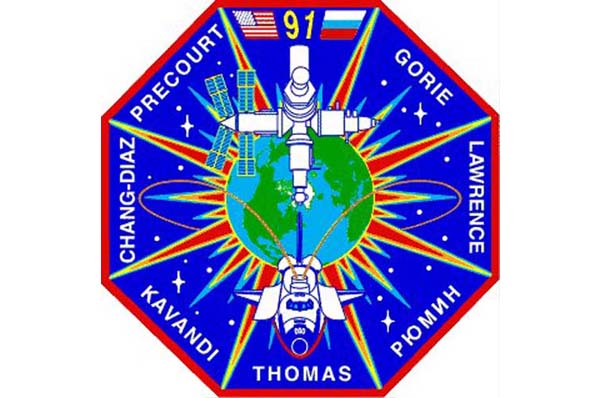
STS-91
Mission: Ninth and Final Shuttle-Mir Docking
Space Shuttle: Discovery
Launch Pad: 39A
Launched: June 2, 1998, 6:06:24 p.m. EDT
Landing Site: Kennedy Space Center, Florida
Landing: June 12 1998, 2:00:18 p.m. EDT
Mission Duration: 9 days, 19 hours, 54 minutes, 2 seconds
Orbit Inclination: 51.6 degrees
Docking of Discovery to Mir, the first for that orbiter, occurred at 12:58 p.m., June 4, at an altitude of 208 miles. Hatches opened at 2:34 p.m. the same day. At hatch opening, Andy Thomas officially became a member of Discovery's crew, completing 130 days of living and working on Mir. The transfer wrapped up a total of 907 days spent by seven U.S. astronauts aboard the Russian space station as long-duration crew members. During the next four days, the Mir 25 and STS-91 crews transferred more than 1,100 pounds of water, and almost 4,700 pounds of cargo experiments and supplies were exchanged between the two spacecraft. During this time, long-term U.S. experiments aboard the Mir were moved into Discovery’s middeck locker area and the SPACEHAB single module in the orbiter's payload bay, including the Space Acceleration Measurement System (SAMS) and the tissue engineering co-culture (COCULT) investigations, as well as two crystal growth experiments. The crews also conducted Risk Mitigation Experiments (RMEs) and Human Life Sciences (HLS) investigations. When the hatches closed for undocking at 9:07 a.m., June 8, and the spacecraft separated at 12:01 p.m. that day, the final Shuttle-Mir docking mission was concluded and Phase 1 of the International Space Station (ISS) program came to an end.
The Alpha Magnetic Spectrometer (AMS) flew for the first time on this mission.
Crew consisted of Commander Charles J. Precourt, Pilot Dominic L. Pudwill Gorie, Mission Specialists Wendy B. Lawrence, Franklin R. Chang-Diaz, Janet L. Kavandi and Valery Victorovitch Ryumin.
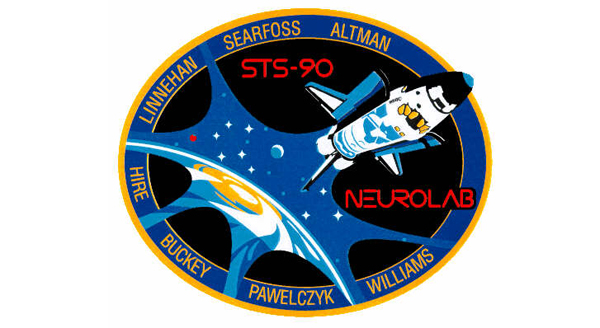
STS-90
Mission: Final Spacelab Mission
Space Shuttle: Columbia
Launch Pad: 39B
Launched: April 17, 1998, 2:19:00 p.m. EDT
Landing Site: Kennedy Space Center, Florida
Landing: May 3, 1998, 12:08:59 p.m. EDT
Mission Duration: 15 days, 21 hours, 50 minutes, 58 seconds
Orbit Altitude: 150 nautical miles
Orbit Inclination: 39 degrees
Neurolab's 26 experiments targeted one of the most complex and least understood parts of the human body — the nervous system. The primary goals were to conduct basic research in neurosciences and expand understanding of how the nervous system develops and functions in space. Test subjects were crew members and rats, mice, crickets, snails and two kinds of fish. This was a cooperative effort of NASA, several domestic partners and the space agencies of Canada (CSA), France (CNES) and Germany (DARA), as well as the European Space Agency (ESA) and the National Space Development Agency of Japan (NASDA). Most experiments were conducted in the pressurized Spacelab long module located in Columbia's payload bay. This was the 16th and last scheduled flight of the ESA-developed Spacelab module although the Spacelab pallets will continue to be used on the International Space Station. Read more about the Neurolab Spacelab Mission findings in this book.
Research was conducted as planned, with the exception of the Mammalian Development Team, which had to reprioritize science activities because of the unexpected high mortality rate of neonatal rats on board.
STS-90 Mission Specialist Kay Hire was Kennedy Space Center's first employee to be chosen as an astronaut candidate.
Crew consisted of Commander Richard A. Searfoss, Pilot Scott D. Altman, Mission Specialists Richard M. Linnehan, Dafydd Rhys Williams, Kathryn P. Hire, Payload Specialists Dr. Jay C. Buckey, Jr. and Dr. James A. Pawelczyk.
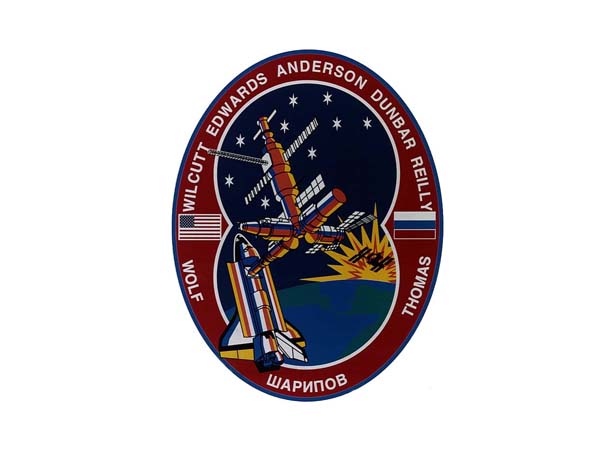
STS-89
Mission: Eighth Shuttle-Mir Docking
Space Shuttle: Endeavour
Launch Pad: 39A
Launched: January 22, 1998, 9:48:15 p.m. EST
Landing Site: Kennedy Space Center, Florida
Landing: January 31, 1998, 5:35:09 p.m. EST
Mission Duration: 8 days, 19 hours, 46 minutes, 54 seconds
Docking of Endeavour to Mir occurred at 3:14 p.m., Jan. 24, at an altitude of 214 nautical miles. Hatches opened at 5:25 p.m. the same day. Transfer of Andy Thomas to Mir and return of David Wolf to the U.S. orbiter occurred at 6:35 p.m., Jan. 25. Initially, Thomas thought his Sokol pressure suit did not fit, and the crew exchange was allowed to proceed only after Wolf's suit was adjusted to fit Thomas. Once on Mir, Thomas was able to make adequate adjustments to his own suit (which would be worn should the crew need to return to Earth in the Soyuz capsule) and this remained on Mir with him. Wolf spent a total of 119 days aboard Mir, and after landing his total on-orbit time was 128 days.
More than 8,000 pounds (3,629 kilograms) of scientific equipment, logistical hardware and water were taken from Endeavour to Mir.
Crew consisted of Commander Terrence W. Wilcutt, Pilot Joe F. Edwards, Jr., Payload Commander Bonnie J. Dunbar, Mission Specialists Michael P. Anderson, James F. Reilly, Salizhan Shakirovich Sharipov and Andrew S. W. Thomas.
1997
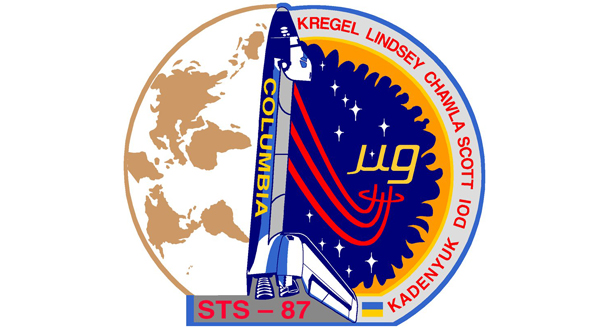
STS-87
Mission: USMP-4; Spartan 201-04
Space Shuttle: Columbia
Launch Pad: 39B
Launched: November 19, 1997, 2:46:00 p.m. EST
Landing Site: Kennedy Space Center, Florida
Landing: December 5, 1997, 7:20:04 a.m. EST
Mission Duration: 15 days, 16 hours, 34 minutes, 4 seconds
Orbit Altitude: 150 nautical miles
Orbit Inclination: 28.45 degrees
Primary payload of the flight, the U.S. Microgravity Payload-4, performed well. Research using other major payload, SPARTAN-201-04 free-flyer, was not completed.
SPARTAN deploy delayed one day to Nov. 21 to allow time for companion spacecraft, the Solar and Heliospheric Observatory (SOHO) already on-orbit, to come back on-line. Chawla used orbiter's mechanical arm to release SPARTAN at 4:04 p.m. Spacecraft failed to execute a pirouette maneuver several minutes later, suggesting there was a problem with the attitude control system for fine pointing toward solar targets. Chawla then regrappled the SPARTAN, but did not receive a firm capture indication. When she backed the arm away once more, a rotational spin of about two degrees per second was apparently imparted to the satellite. Kregel tried to match the satellite's rotation by firing Columbia's thrusters for a second grapple attempt, but this was called off by the flight director.
After a plan was formulated to retrieve the free-flyer, Scott and Doi began a seven-hour, 43-minute space walk Nov. 24 and captured the SPARTAN by hand at 9:09 p.m. EST. The two astronauts then completed a series of activities that continue preparations for on-orbit assembly of the International Space Station. Doi became the first Japanese citizen to walk in space.
Crew consisted of Commander Kevin R. Kregel, Pilot Steven W. Lindsey, Mission Specialists Winston E. Scott, Kalpana Chawla, Takao Doi and Leonid K. Kadenyuk.
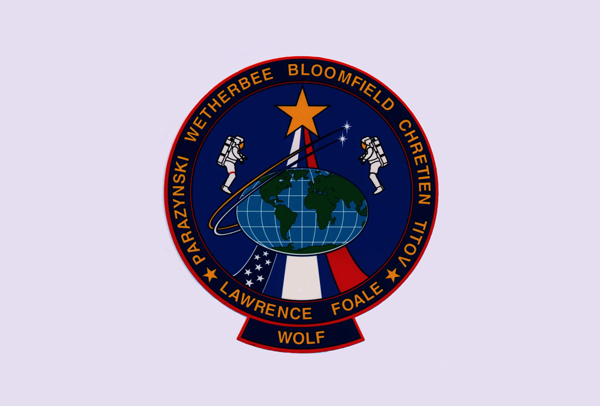
STS-86
Mission: Seventh Shuttle-Mir Docking
Space Shuttle: Atlantis
Launch Pad: 39A
Launched: September 25, 1997, 10:34:19 p.m. EDT
Landing Site: Kennedy Space Center, Florida
Landing: October 6, 1997, 5:55:09 p.m. EDT
Mission Duration: 10 days, 19 hours, 20 minutes, 50 seconds
Orbit Altitude: 184 statute miles
Orbit Inclination: 51.6 degrees
The seventh Mir docking mission continued the presence of a U.S. astronaut on the Russian space station with the transfer of physician David A. Wolf to Mir. Wolf became the sixth U.S. astronaut in succession to live on Mir to continue Phase 1B of the NASA/Russian Space agency cooperative effort.
First joint U.S.-Russian extravehicular activity during a shuttle mission, which was also the 39th in the space shuttle program, was conducted by Titov and Parazynski.
During the six days of docked operations, the joint Mir 24 and STS-86 crews transferred more than four tons of material from the SPACEHAB Double Module to Mir, including approximately 1,700 pounds of water, experiment hardware for International Space Station Risk Mitigation experiments to monitor the Mir for crew health and safety, a gyrodyne, batteries, three air pressurization units with breathing air, an attitude control computer and many other logistics items. The new motion control computer replaced one that had experienced problems in recent months. The crew also moved experiment samples and hardware and an old Elektron oxygen generator to Atlantis for return to Earth.
Crew consisted of Commander James D. Wetherbee, Pilot Michael J. Bloomfield, Mission Specialists Vladimar G. Titov, Scott E. Parazynski, Jean-Loup J. M. Chretien, Wendy B. Lawrence and David A. Wolf.
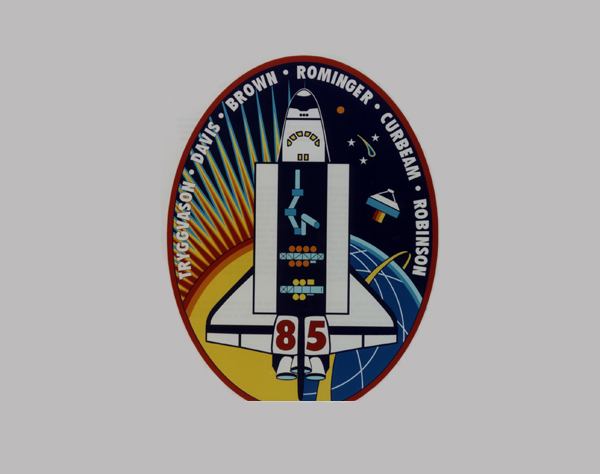
STS-85
Mission: CRISTA-SPAS-02
Space Shuttle: Discovery
Launch Pad: 39A
Launched: August 7, 1997, 10:41:00 a.m. EDT
Landing Site: Kennedy Space Center, Florida
Landing: August 19, 1997, 7:07:59 a.m. EDT
Mission Duration: 11 days, 19 hours, 18 minutes, 47 seconds
Orbit Altitude: 173 statute miles
Orbit Inclination: 51.6 degrees
STS-85 carried a complement of payloads in the cargo bay that focused on Mission to Planet Earth objectives as well as preparations for International Space Station assembly: the Cryogenic Infrared Spectrometers and Telescopes for the Atmosphere-Shuttle Pallet Satellite-2 (CRISTA-SPAS-02); the Japanese Manipulator Flight Development (MFD); the Technology Applications and Science-01 (TAS-1) and the International Extreme Ultraviolet Hitchhiker-02 (IEH-02).
This was the second flight of CRISTA-SPAS payload.
Crew consisted of Commander Curtis L. Brown, Pilot Kent V. Rominger, Mission Specialists N. Jan Davis, Robert L. Curbeam, Jr., Stephen K. Robinson, and Payload Specialist Bjarni V. Tryggvason.
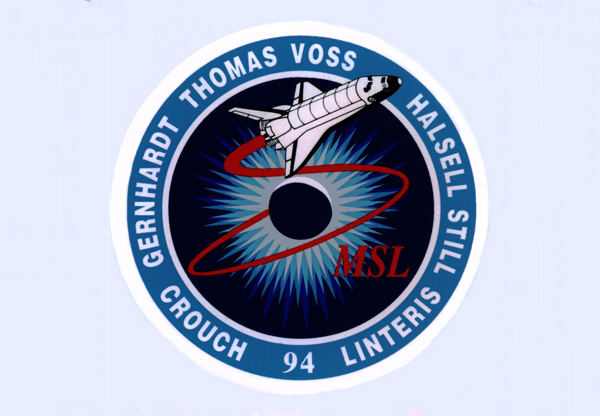
STS-94
Mission: MSL-1 Reflight
Space Shuttle: Columbia
Launch Pad: 39A
Launched: July 1, 1997 2:02:00 p.m. EDT
Landing Site: Kennedy Space Center, Florida
Landing: July 17, 1997, 6:46:34 a.m. EDT
Mission Duration: 15 days, 16 hours, 44 minutes, 34 seconds
Orbit Altitude: 184 statute miles
Orbit Inclination: 28.45 degrees
STS-94 marked the first reflight of same vehicle, crew and payloads, following shortened STS-83 mission in April due to indications of a fuel cell problem. Primary payload was the Microgravity Science Laboratory-1 (MSL-1). A quick turnaround in processing Columbia for the reflight was accomplished in part by the first reservicing of a primary payload, MSL-1, in the orbiter.
The crew maintained 24-hour/two-shift operations. Using the Spacelab module as a test-bed, MSL-1 tested some of the hardware, facilities and procedures that will be used on the International Space Station. The 33 investigations conducted also yielded new knowledge in the principal scientific fields of combustion, biotechnology and materials processing.
Crew consisted of Commander James D. Halsell, Pilot Susan L. Still, Payload Commander Janice E. Voss, Mission Specialists Donald A. Thomas, Michael L. Gernhardt, Payload Specialists Roger Crouch and Greg Linteris.
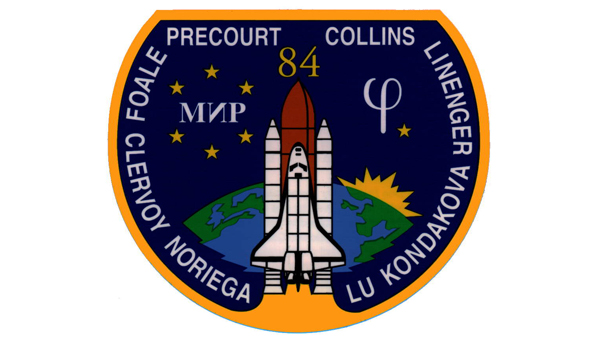
STS-84
Mission: Sixth Shuttle-Mir Docking
Space Shuttle: Atlantis
Launch Pad: 39A
Launched: May 15, 1997 4:07:48 a.m. EDT
Landing Site: Kennedy Space Center, Florida
Landing: May 24, 1997, 9:27:44 a.m. EDT
Mission Duration: 9 days, 23 hours, 19 minutes, 56 seconds
Orbit Altitude: 184 statute miles
Orbit Inclination: 51.6 degrees
Sixth Shuttle-Mir docking highlighted by transfer of fourth successive U.S. crew member to the Russian Space Station. U.S. astronaut Mike Foale exchanged places with Jerry Linenger, who arrived at Mir Jan. 15 with the crew of shuttle mission STS-81.
Transfer of items to and from Mir proceeded smoothly and was completed ahead of schedule. One of first items transferred to the station was an Elektron oxygen-generating unit. Altogether about 249 items were moved between the two spacecraft, and about 1,000 pounds of water moved to Mir, for a total of about 7,500 pounds of water, experiment samples, supplies and hardware.
Other activities conducted during the mission included investigations using the Biorack facility, located in the SPACEHAB Double Module in Atlantis' payload bay, a photo survey of Mir during docked operations, environmental air samplings and radiation monitoring.
Crew consisted of Commander James D. Halsell, Pilot Susan L. Still, Payload Commander Janice E. Voss, Mission Specialists Donald A. Thomas, Michael L. Gernhardt, Payload Specialists Roger Crouch and Greg Linteris.
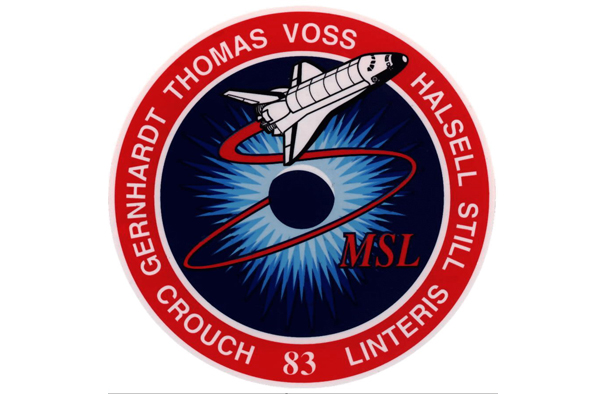
STS-83
Mission: MSL-1
Space Shuttle: Columbia
Launch Pad: 39A
Launched: April 4, 1997, 2:20:32 p.m. EST
Landing Site: Kennedy Space Center, Florida
Landing: April 8, 1997, 2:33:11 p.m. EDT
Mission Duration: 3 days, 23 hours, 13 minutes, 38 seconds
Orbit Altitude: 184 statute miles
Orbit Inclination: 28.45 degrees
First flight of the Microgravity Science Laboratory-1 (MSL-1) cut short due to concerns about one of three fuel cells, marking only the third time in shuttle program history a mission ended early. (STS-2, 1981 and STS-44, 1991 were other two times).
Crew was able to conduct some science in the MSL-1 Spacelab module despite the early return. Work was performed in the German electromagnetic levitation furnace facility (TEMPUS) on an experiment called Thermophysical Properties of Undercooled Metallic Melts. This experiment studies the amount of undercooling that can be achieved before solidification occurs. Another experiment performed was the Liquid-Phase Sintering II experiment in the Large Isothermal Furnace. This investigation uses heat and pressure to test theories about how the liquefied component bonds with the solid particles of a mixture without reaching the melting point of the new alloy combination.
A decision to refly the mission in its entirety was made by the Mission Management Team in the days following Columbia's return. The reflight was first designated STS-83R and then renamed STS-94.
Crew consisted of Commander James D. Halsell, Pilot Susan L. Still, Payload Commander Janice E. Voss, Mission Specialists Donald A. Thomas, Michael L. Gernhardt, Payload Specialists Roger Crouch and Greg Linteris.
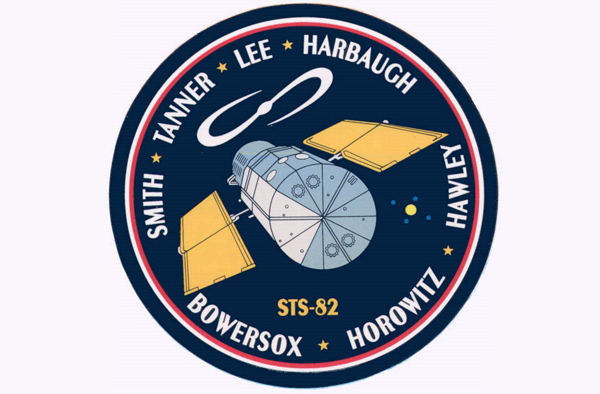
STS-82
Mission: Second HST Servicing
Space Shuttle: Discovery
Launch Pad: 39A
Launched: February 11, 1997 3:55:17 a.m. EST
Landing Site: Kennedy Space Center, Florida
Landing: February 21, 1997, 3:32 a.m. EST
Mission Duration: 9 days, 23 hours, 37 minutes, 9 seconds
Orbit Altitude: 360 statute miles
Orbit Inclination: 28.45 degrees
STS-82 demonstrated anew the capability of the space shuttle to service orbiting spacecraft as well as the benefits of human spaceflight. A six-member crew completed servicing and upgrading of the Hubble Space Telescope (HST) during four planned extravehicular activities (EVAs) and then performed a fifth unscheduled space walk to repair insulation on the telescope.
Discovery's maneuvering jets fired several times during the mission to reboost the telescope's orbit by eight nautical miles. Hubble redeployed on Feb. 19 at 1:41 a.m. and is now operating at the highest altitude it has ever flown, a 335- by 321-nautical-mile orbit. Initial checkout of new instruments and equipment during mission showed all were performing nominally. Calibration of two new science instruments was to take place over a period of several weeks with first images and data anticipated in about 8 to 10 weeks. Two more servicing are missions planned for 1999 and 2002.
Crew consisted of Commander Kenneth D. Bowersox, Pilot Scott J. Horowitz, Mission Specialists Mark C. Lee, Steven A. Hawley, Gregory J. Harbaugh, Steven L. Smith and Joseph R. Tanner.
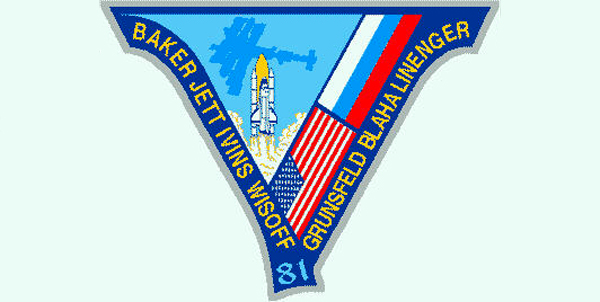
STS-81
Mission: Fifth Shuttle-Mir Docking
Space Shuttle: Atlantis
Launch Pad: 39B
Launched: January 12, 1997, 4:27:23 a.m. EST
Landing Site: Kennedy Space Center, Florida
Landing: January 22, 1997, 9:22:44 a.m. EST
Mission Duration: 10 days, 4 hours, 55 minutes, 21 seconds
Orbit Altitude: 184 statute miles
Orbit Inclination: 51.60 degrees
The first shuttle flight of 1997 which was highlighted by the return of U.S. astronaut John Blaha to Earth after 118-day stay aboard the Russian Space Station Mir and the largest transfer to date of logistics between the two spacecraft. Atlantis also returned carrying the first plants to complete a life cycle in space — a crop of wheat grown from seed to seed. This fifth of nine planned dockings continued Phase 1B of the NASA/Russian Space Agency cooperative effort, with Linenger becoming the third U.S. astronaut in succession to live on Mir. Same payload configuration flown on previous docking flight — featuring SPACEHAB Double module — flown again.
Blaha joined Mir 22 crew of Commander Valeri Korzun and Flight Engineer Aleksandr Kaleri on Sept. 19, 1996, when he arrived there with the crew of STS-79. Linenger was to work with the Mir 22 crew until the arrival in February of the Mir 23 crew of Commander Vasili Tsibliev, Flight Engineer Aleksandr Lazutkin and German researcher Reinhold Ewald.
During five days of mated operations, crews transferred nearly 6,000 pounds (2,722 kilograms) of logistics to Mir, including around 1,600 pounds of water; around 1,138 pounds of U.S. science equipment; and 2,206 pounds of Russian logistical equipment. About 2,400 pounds of materials returned with Atlantis from Mir.
1996
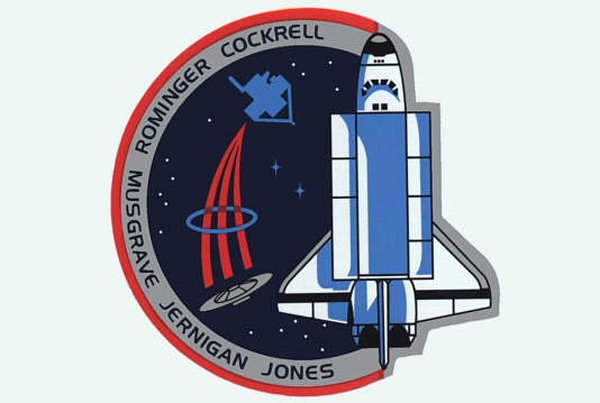
STS-80
Mission: ORFEUS-SPAS II; WSF-3
Space Shuttle: Columbia
Launch Pad: 39B
Launched: November 19, 1996, 2:55:47 p.m. EST
Landing Site: Kennedy Space Center, Florida
Landing: December 7, 1996, 6:49:05 a.m. EST
Mission Duration: 17 days, 15 hours, 53 minutes, 18 seconds
Orbit Altitude: 218 statute miles
Orbit Inclination: 28.45 degrees
Final shuttle flight of 1996 was highlighted by the successful deployment, operation and retrieval of two free-flying research spacecraft. The two planned extravehicular activities (EVAs) were canceled.
Orbiting and Retrievable Far and Extreme Ultraviolet Spectrometer-Shuttle Pallet Satellite II (ORFEUS-SPAS II) deployed on flight day one to begin approximately two weeks of data- gathering. Making its second flight aboard the shuttle, ORFEUS-SPAS II featured three primary scientific instruments: the ORFEUS-Telescope with the Far Ultraviolet (FUV) Spectrograph and Extreme Ultraviolet (EUV) Spectrograph.
Wake Shield Facility-3 (WSF-3) deployed on flight day 4. WSF is a 12-foot diameter, free-flying stainless steel disk designed to generate ultravacuum environment in which to grow semiconductor thin films for use in advanced electronics.
Two planned six-hour EVAs by Jernigan and Jones were designed to evaluate equipment and procedures that will be used during construction and maintenance of the International Space Station. However, crew could not open outer airlock hatch and when troubleshooting did not reveal cause, mission managers concluded it would not be prudent to attempt the two EVAs and risk unnecessary damage to hatch or seals. Crew was able to evaluate new Pistol Grip Tool, similar to handheld drill, in middeck. Post-landing assessment of hatch indicated a small screw had become loose from an internal assembly and lodged in an actuator — a gearbox-type mechanism that operates linkages that secure the hatch — preventing crew from opening hatch. Hatch opened easily when replacement actuator installed.
Crew consisted of Commander Kenneth D. Cockrell, Pilot Kent V. Rominger, Mission Specialists Tamara E. Jernigan, Thomas D. Jones and F. Story Musgrave.
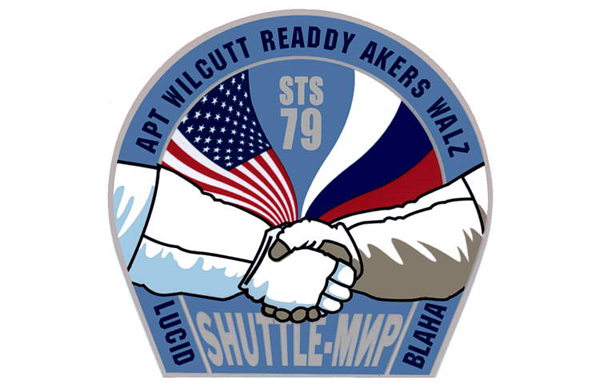
STS-79
Mission: Fourth Shuttle-Mir Docking
Space Shuttle: Atlantis
Launch Pad: 39A
Launched: September 16, 1996, 4:54:49 a.m. EDT
Landing Site: Kennedy Space Center, Florida
Landing: September 26, 1996, 8:13:15 a.m. EDT
Mission Duration: 10 days, 3 hours, 18 minutes, 26 seconds
Orbit Altitude: 196-245 statute miles
Orbit Inclination: 51.6 degrees
STS-79 highlighted by return to Earth of U.S. astronaut Lucid after 188 days in space, first U.S. crew exchange aboard Russian Space Station Mir, and fourth Shuttle-Mir docking. Lucid’s long-duration spaceflight set new U.S. record as well as world record for a woman.
STS-79 also marked second flight of SPACEHAB module in support of Shuttle-Mir activities and first flight of SPACEHAB Double Module configuration.
During five days of mated operations, two crews transferred more than 4,000 pounds (1,814 kilograms) of supplies to Mir, including logistics, food and water generated by orbiter fuel cells. Three experiments also were transferred: Biotechnology System (BTS) for study of cartilage development; Material in Devices as Superconductors (MIDAS) to measure electrical properties of high-temperature superconductor materials; and Commercial Generic Bioprocessing Apparatus (CGBA), containing several smaller experiments, including self-contained aquatic systems.
About 2,000 pounds (907 kilograms) of experiment samples and equipment transferred from Mir to Atlantis; total logistical transfer to and from station of more than 6,000 pounds (2,722 kilograms) was most extensive to date.
Crew consisted of Commander William F. Readdy, Pilot Terrence W. Wilcutt, Mission Specialists Thomas D. Akers, John E. Blaha, Jay Apt and Carl E. Walz.
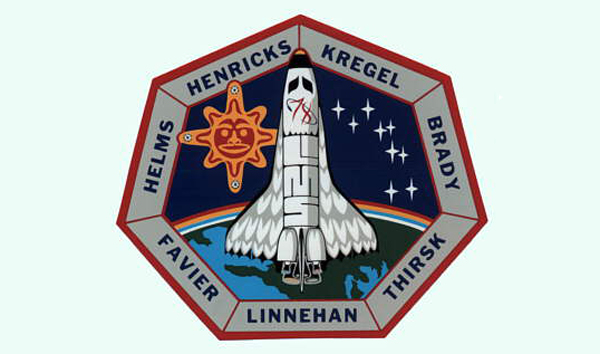
STS-78
Mission: LMS
Space Shuttle: Columbia
Launch Pad: 39B
Launched: June 20, 1996, 10:49:00 a.m. EDT
Landing Site: Kennedy Space Center, Florida
Landing: July 7, 1996, 8:36:45 a.m. EDT
Mission Duration: 16 days, 21 hours, 47 minutes, 45 seconds
Orbit Altitude: 173 statute miles
Orbit Inclination: 39 degrees
Five space agencies (NASA/USA; European Space Agency/Europe; French Space Agency/France; Canadian Space Agency/Canada; and Italian Space Agency/Italy) and research scientists from 10 countries worked together on primary payload of STS-78, Life and Microgravity Spacelab (LMS). More than 40 experiments flown were grouped into two areas: life sciences, which included human physiology and space biology, and microgravity science, which included basic fluid physics investigations, advanced semiconductor and metal alloy materials processing, and medical research in protein crystal growth.
LMS investigations conducted via most extensive telescience to date. Investigators located at four remote European and four remote U.S. locations, similar to what will happen with International Space Station. Mission also made extensive use of video imaging to help crew members perform inflight maintenance procedures on experiment hardware.
Crew consisted of Commander Terence T. Henricks, Pilot Kevin R. Kregel, Flight Engineer Susan J. Helms, Mission Specialists Richard M. Linnehan, Charles E. Brady, Jr., Payload Specialists Jean-Jacques Favier and Robert Brent Thirsk.

STS-77
Mission: SPACEHAB; SPARTAN (IAE)
Space Shuttle: Endeavour
Launch Pad: 39B
Launched: May 19, 1996, 6:30:00 a.m. EDT
Landing Site: Kennedy Space Center, Florida
Landing: May 29, 1996, 7:09:18 a.m. EDT
Mission Duration: 10 days, 0 hours, 39 minutes, 18 seconds
Orbit Altitude: 153 nautical miles
Orbit Inclination: 39 degrees
The fourth shuttle flight of 1996 highlighted by four rendezvous activities with two different payloads. Primary payloads, all located in the cargo bay, were the SPACEHAB-4 pressurized research module; the Inflatable Antenna Experiment (IAE) mounted on Spartan 207 free-flyer; and a suite of four technology demonstration experiments known as Technology Experiments for Advancing Missions in Space (TEAMS). More than 90 percent of the payloads were sponsored by NASA’s Office of Space Access and Technology.
Crew consisted of Commander John H. Casper, Pilot Curtis L. Brown, Jr., Mission Specialists Daniel W. Bursch, Mario Runco, Jr., Marc Garneau and Andrew S. W. Thomas.
Casper spoke with Mir cosmonaut and U.S. astronaut Shannon Lucid, who was entering her 65th day aboard the Mir space station.
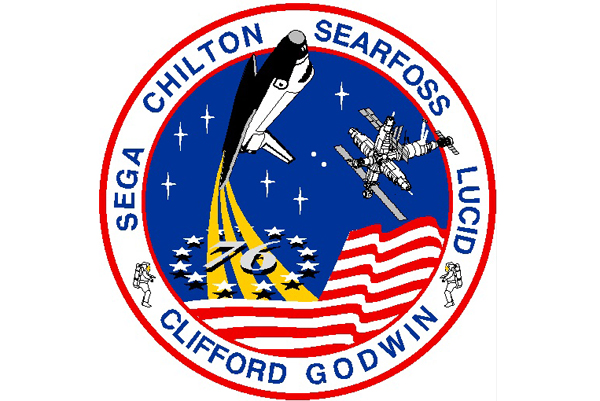
STS-76
Mission: Third Shuttle-Mir Docking; SPACEHAB
Space Shuttle: Atlantis
Launch Pad: 39B
Launched: March 22, 1996, 3:13:04 a.m. EST
Landing Site: Edwards Air Force Base, Calif.
Landing: March 31, 1996, 5:28:57 a.m. PST
Mission Duration: 9 days, 5 hours, 15 minutes, 53 seconds
Orbit Altitude: 160 nautical miles
Orbit Inclination: 56.1 degrees
Third linkup between U.S. space shuttle and Russian Space Station Mir highlighted by transfer of veteran astronaut Shannon Lucid to Mir to become first American woman to live on station. Her approximately four-and-a-half month stay also will eclipse long-duration U.S. spaceflight record set by first American to live on Mir, Norm Thagard.
Payload bay configuration included Orbiter Docking System in forward area and SPACEHAB single module toward the aft. STS-76 marked first flight of SPACEHAB pressurized module to support shuttle-Mir dockings; single module primarily served as stowage area for large supply of equipment slated for transfer to space station, but also carried European Space Agency’s Biorack experiment rack for on-orbit research.
During five days of docked operations, about 1,500 pounds (680 kilograms) of water and two tons of scientific equipment, logistical material and resupply items transferred to Mir; experiment samples and miscellaneous equipment brought over to orbiter. In Biorack, 11 separate scientific investigations were conducted. Study topics included effect of microgravity and cosmic radiation on plants, tissues, cells, bacteria and insects and effects of microgravity on bone loss.
Crew consisted of Commander Kevin P. Chilton, Pilot Richard A. Searfoss, Mission Specialists Shannon W. Lucid, Linda M. Godwin, Michael R. Clifford, Ronald M. Sega.
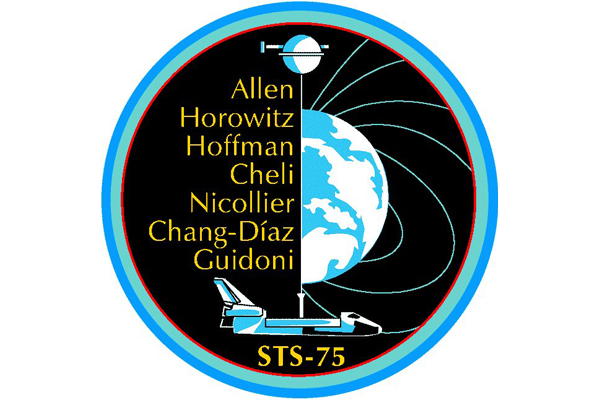
STS-75
Mission: TSS-1R; USMP-3
Space Shuttle: Columbia
Launch Pad: 39B
Launched: February 22, 1996, 3:18:00 p.m. EST
Landing Site: Kennedy Space Center, Florida
Landing: March 9, 1996, 8:58:21 a.m. EST
Mission Duration: 15 days, 17 hours, 41 minutes, 25 seconds
Orbit Altitude: 160 nautical miles
Orbit Inclination: 28.45 degrees
Reflight of U.S./Italian Tethered Satellite System (TSS-1R) marred by loss of satellite on flight day three, although valuable scientific data was still gathered. Other primary payload, U.S. Microgravity Payload-3 (USMP-3), performed nominally. TSS considered primary payload at beginning of mission and USMP-3 primary following TSS operations.
TSS flew previously on Mission STS-46 in June 1992, but experiment operations curtailed due to jammed tether. TSS concept designed to study electrodynamics of a tether system in electrically charged portion of Earth's atmosphere called the ionosphere. Satellite provided by Italy and tether/deployer assembly U.S.-built. Twelve investigations — six NASA, five Italian Space Agency (ASI) and one U.S. Air Force — planned. Deployment of TSS-1R on STS-75 delayed one day to allow troubleshooting of onboard TSS computers by flight crew. Excellent scientific data was being gathered when tether snapped on flight day three as satellite was just short of full deployment of about 12.8 miles (20.6 kilometers). Satellite immediately began speeding away from orbiter as a result of orbital forces and the crew was never in any danger. Reason for tether break not immediately clear and investigative board convened on ground to determine cause. Crew retracted deployer and remaining tether following day.
Meanwhile, scientists did gather useful data from curtailed deployment. Some experiments conducted using free-flying satellite and attached tether before it re-entered Earth's atmosphere and broke up.
Crew consisted of Commander Andrew M. Allen, Pilot Scott J. Horowitz, Payload Commander Franklin R. Chang-Diaz, Mission Specialists Maurizio Cheli, Jeffrey A. Hoffman, Claude Nicollier and Umberto Guidoni.
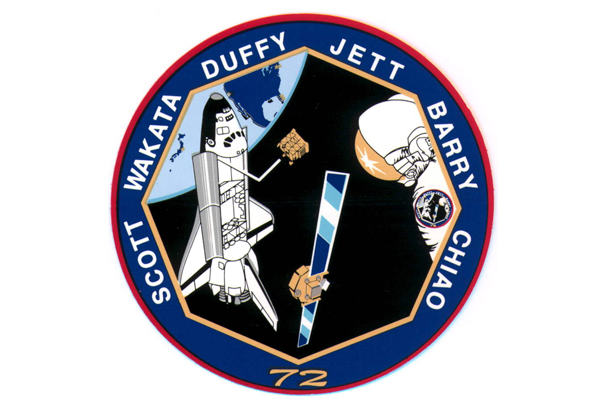
STS-72
Mission: SFU; OAST-Flyer
Space Shuttle: Endeavour
Launch Pad: 39B
Launched: January 11, 1996, 4:41:00 a.m. EST
Landing Site: Kennedy Space Center, Florida
Landing: January 20, 1996, 2:41:41 a.m. EST
Mission Duration: 8 days, 22 hours, 1 minute, 47 seconds
Orbit Altitude: 250 nautical miles
Orbit Inclination: 28.45 degrees
First shuttle flight of 1996 highlighted by retrieval of a Japanese satellite, deployment and retrieval of a NASA science payload, and two spacewalks.
Mission Specialist Wakata operated remote manipulator system arm on flight day three to pluck Japanese Space Flyer Unit (SFU) from orbit, completing 10-month scientific mission involving almost a dozen experiments ranging from materials science to biological studies. Both solar arrays on SFU had to be jettisoned prior to retrieval when sensors indicated improper latching following retraction.
On flight day four, Wakata again operated Endeavour's robot arm, this time to deploy Office of Aeronautics and Space Technology-Flyer (OAST-Flyer), sending experiment-laden platform on its way to a two-day free-flight at a distance of approximately 45 miles (72 kilometers) from the orbiter. OAST-Flyer retrieved on flight day six, with Wakata again operating the remote manipulator system arm to retrieve the platform.
Two extravehicular activities (EVAs) conducted as part of continuing series to prepare for on-orbit construction of International Space Station. During first EVA on flight day five lasting 6 hours, nine minutes, Mission Specialists Chiao and Barry evaluated new portable work platform and a structure known as the rigid umbilical, which may be used on station to hold various fluid and electrical lines.
Crew consisted of Commander Brian Duffy, Pilot Brent W. Jett, Mission Specialists Leroy Chiao, Daniel T. Barry, Winston E. Scott and Koichi Wakata.
1995
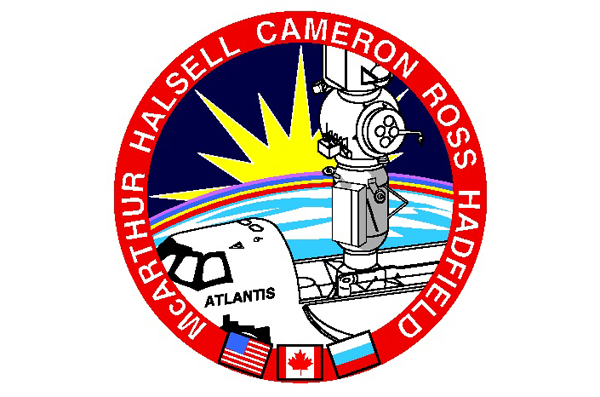
STS-74
Mission: Second Shuttle-Mir Docking
Space Shuttle: Atlantis
Launch Pad: 39A
Launched: November 12, 1995 at 7:30:43.071 a.m. EST
Landing Site: Kennedy Space Center, Florida
Landing: November 20, 1995 at 12:01:27 p.m. EST
Mission Duration: 8 days, 4 hours, 30 minutes, 44 seconds
Orbit Altitude: 213 nautical miles
Orbit Inclination: 51.6 degrees
STS-74 marked second docking of U.S. Space Shuttle to Russian Space Station Mir, continuing Phase I activities leading to construction of International Space Station later this decade. Mission illustrated international flavor of space station effort: shuttle crew included Hadfield, fourth Canadian to fly on shuttle but first Canadian mission specialist. Hardware in payload bay included Canadian-built Remote Manipulator System (RMS) arm, U.S.-built Orbiter Docking System (ODS), Russian-built docking module and solar array and U.S.-Russian-built solar array. Awaiting Atlantis aboard Mir were two Russian cosmonauts and a German cosmonaut, along with Russian and European Space Agency research samples and equipment.
Unlike first docking flight during which crew exchange took place, second docking focused on delivery of equipment to Mir. Primary payload of mission was Russian-built Docking Module (DM), designed to become permanent extension on Mir to afford better clearances for Shuttle-Mir linkups. Two solar arrays were stowed on DM for later transfer to Mir by spacewalking cosmonauts.
Crew consisted of Commander Kenneth D. Cameron, Pilot James D. Halsell Jr., Mission Specialists Jerry L. Ross, William S. McArthur Jr. and Chris A. Hadfield.
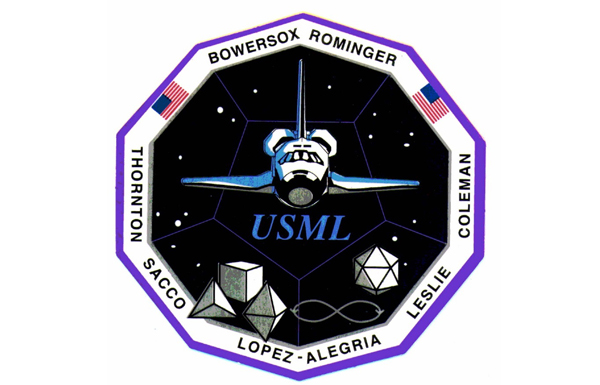
STS-73
Mission: USML-2
Space Shuttle: Columbia
Launch Pad: 39B
Launched: October 20, 1995 at 9:53:00 a.m. EDT
Landing Site: Kennedy Space Center, Florida
Landing: November 5, 1995 at 6:45:21 a.m. EST
Mission Duration: 15 days, 21 hours, 52 minutes, 28 seconds
Orbit Altitude: 150 nautical miles
Orbit Inclination: 39 degrees
STS-73 marked second flight of U.S. Microgravity Laboratory (USML) and built on foundation of its predecessor, which flew on Columbia during Mission STS-50 in 1992. Research during USML-2 concentrated within same overall areas of USML-1, with many experiments flying for second time. Crew divided into two teams to work around the clock in 23-foot (seven-meter) long Spacelab module located in Columbia's payload bay.
Crew took time out from Spacelab work to tape ceremonial first pitch for Game Five of baseball World Series, marking first time the thrower was not actually in the ballpark for the pitch.
Crew consisted of Commander Kenneth D. Bowersox, Pilot Kent V. Rominger, Payload Commander Kathryn C. Thornton, Mission Specialists Catherine G. Coleman, Michael E. Lopez-Alegria, Payload Specialists Fred W. Leslie and Albert Sacco, Jr.
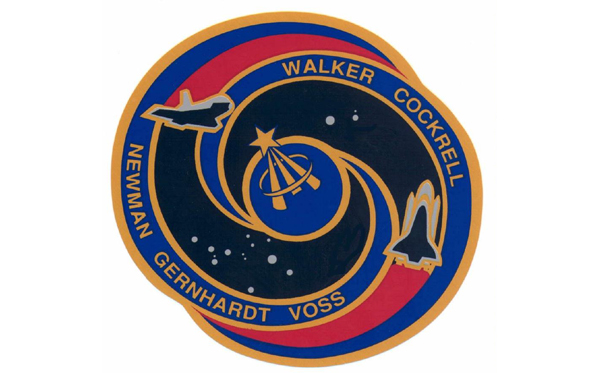
STS-69
Mission: SPARTAN 201-03; WSF-2
Space Shuttle: Endeavour
Launch Pad: 39A
Launched: September 7, 1995 at 11:09:00.052 a.m. EDT
Landing Site: Kennedy Space Center, Florida
Landing: September 18, 1995 at 7:37:56 a.m. EDT
Mission Duration: 10 days, 20 hours, 28 minutes, 56 seconds
Orbit Altitude: 190 nautical miles
Orbit Inclination: 28.4 degrees
STS-69 marked first time two different payloads were retrieved and deployed during the same mission. Also featured an extravehicular activity to practice for International Space Station activities and to evaluate space suit design modifications.
First of two primary payloads, Spartan 201-03, deployed on flight day two. This was the third Spartan 201 mission in planned series of four. Primary objective was to study outer atmosphere of sun and its transition into solar wind that constantly flows past Earth. Timing of Spartan 201-03 flight intended to coincide with passage of the Ulysses spacecraft over the sun's north polar region to expand range of data being collected about origins of solar wind. Spartan 201-03 configuration featured two scientific instruments, the Ultraviolet Coronal Spectrometer (UVCS) and the White Light Coronagraph (WLC). UVCS measured characteristics of light emitted by neutral hydrogen atoms in the solar corona, the outermost portion of the sun's atmosphere from which the solar wind evolves. The WLC imaged the changing shape and form of the corona.
Second primary payload, Wake Shield Facility-2 (WSF-2) deployed on flight day five and became first spacecraft to maneuver itself away from orbiter rather than other way around, by firing small cold gas nitrogen thruster to maneuver away from Endeavour. WSF-2 second in planned series of four flights. WSF is a 12-foot- (3.7-meter) diameter stainless steel disk designed to generate an ultravacuum environment in space within which to grow thin films for next generation advanced electronics.
Crew consisted of Commander David M. Walker, Pilot Kenneth D. Cockrell, Payload Commander James S. Voss, Mission Specialists James H. Newman and Michael L. Gernhardt.
STS-69 also was second flight of a "dog crew," a flight crew tradition that began on STS-53, on which both Walker and Voss flew. As the Dog Crew II, each STS-69 astronaut adopted a dogtag or nickname: Walker was Red Dog; Cockrell was Cujo; Voss, Dog Face; Newman, Pluto; and Gernhardt, Under Dog.
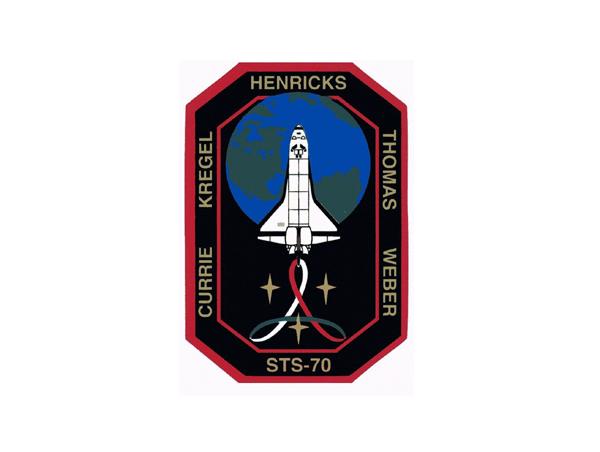
STS-70
Mission: TDRS-G
Space Shuttle: Discovery
Launch Pad: 39B
Launched: July 13, 1995 at 9:41:55.078 a.m. EDT
Landing Site: Kennedy Space Center, Florida
Landing: July 22, 1995 at 8:02 a.m. EDT
Mission Duration: 8 days, 22 hours, 20 minutes, 5 seconds
Orbit Altitude: 160 nautical miles
Orbit Inclination: 28.45 degrees
Primary objective of the mission accomplished when Tracking and Data Relay Satellite-G deployed from orbiter payload bay about six hours after liftoff. Approximately one hour after deployment, Inertial Upper Stage (IUS) booster attached to TDRS-G completed first of two scheduled burns to place TDRS-G in geosynchronous orbit.
During remainder of mission, five crew members completed variety of experiments. Biological Research in Canister (BRIC) experiments study effects of microgravity on wide range of physiological processes in plants, insects and small invertebrate animals. BRIC-4 examined how hormone system and muscle formation of tobacco hornworm affected by microgravity; BRIC-5 tested whether cell division changes in daylily are due to microgravity or other causes. Also, Bioreactor Development System (BDS), composed of device developed at Johnson Space Center, used colon cancer cells to test bioreactor performance in microgravity; this experiment worked extremely well, yielding tissue cultures better than any seen previously.
STS-70 marked first flight of new Block I main engine featuring new high-pressure liquid oxidizer turbopump built by Pratt & Whitney. Engine 2036 flew in number one position; other two main engines were of existing Phase II design.
Crew consisted of Commander Terence T. Henricks, Pilot Kevin R. Kregel, Mission Specialists Nancy Jane Currie, Donald A. Thomas and Mary Ellen Weber.
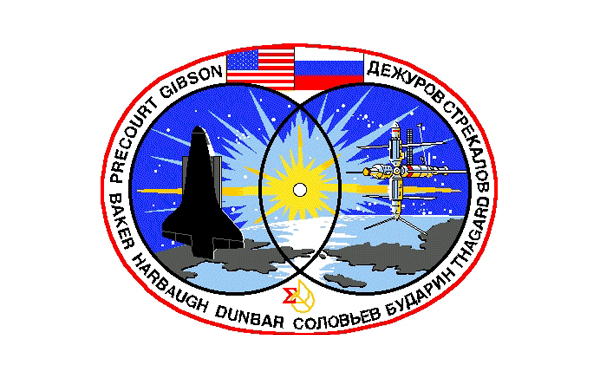
STS-71
Mission: First Shuttle-Mir Docking
Space Shuttle: Atlantis
Launch Pad: 39A
Launched: June 27, 1995, 3:32:19.044 p.m. EDT
Landing Site: Kennedy Space Center, Florida
Landing: July 7, 1995, 10:54:34 a.m. EDT
Mission Duration: 9 days, 19 hours, 22 minutes, 17 seconds
Orbit Altitude: 170 nautical miles
Orbit Inclination: 51.6 degrees
STS-71 marked a number of historic firsts in human spaceflight: 100th U.S. human space launch conducted from the Cape; first U.S. space shuttle-Russian Space Station Mir docking and joint on-orbit operations; largest spacecraft ever in orbit; and first on-orbit changeout of shuttle crew.
When linked, Atlantis and Mir formed largest spacecraft ever in orbit, with a total mass of almost one-half million pounds (about 225 tons) orbiting some 218 nautical miles above the Earth. After hatches on each side opened, STS-71 crew passed into Mir for welcoming ceremony. On same day, Mir 18 crew officially transferred responsibility for station to Mir 19 crew, and two crews switched spacecraft.
For next five days, about 100 hours total, joint U.S.-Russian operations conducted, including biomedical investigations, and transfer of equipment to and from Mir. Fifteen separate biomedical and scientific investigations were conducted, using Spacelab module installed in aft portion of Atlantis' payload bay, and covering seven different disciplines: cardiovascular and pulmonary functions; human metabolism; neuroscience; hygiene, sanitation and radiation; behavioral performance and biology; fundamental biology; and microgravity research. Mir 18 crew served as test subjects for investigations. Three Mir 18 crew members also carried out intensive program of exercise and other measures to prepare for re-entry into gravity environment after more than three months in space.
Crew consisted of Commander Robert L. Gibson, Pilot Charles J. Precourt, Mission Specialists Ellen S. Baker, Bonnie J. Dunbar and Gregory J. Harbaugh. Mir 19 Crew (upload) Anatoly Solovyev, Nikolai Budarin and Mir 18 Crew (download) Norman E. Thagard, Vladimir Dezhurov and Gannady Strekalov.
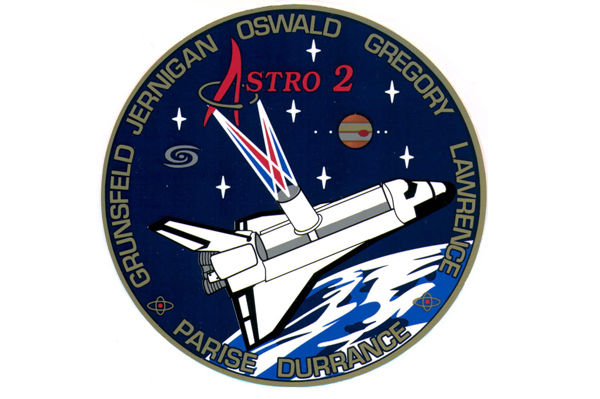
STS-67
Mission: ASTRO-2
Space Shuttle: Endeavour
Launch Pad: 39A
Launched: March 2, 1995. 1:38:13 a.m. EST
Landing Site: Edwards Air Force Base, Calif.
Landing: March 18, 1995 at 1:47:01 p.m. PST
Mission Duration: 16 days, 15 hours, 08 minutes, 48 seconds
Orbit Altitude: 187 nautical miles
Orbit Inclination: 28.45 degrees
Endeavour logged 6.9 million miles (11 million kilometers) in completing the longest shuttle flight to date, allowing sustained examination of the "hidden universe" of ultraviolet light. Primary payload, Astro Observatory, flown once before — on STS-35 in December 1990 — but second flight had almost twice the duration. Planned Astro-2 observations built on discoveries made by Astro-1, as well as seeking answers to other questions.
Astro-2 marked the second flight of three ultraviolet telescopes flown on Astro-1, mounted on Instrument Pointing System on Spacelab pallet in cargo bay. Hopkins Ultraviolet Telescope (HUT), developed at the Johns Hopkins University, performs spectroscopy in far ultraviolet region of spectrum to identify physical processes and chemical composition of a celestial object. Improvements made to HUT after Astro-1 made it three times more sensitive. Wisconsin Ultraviolet Photo-Polarimeter Experiment (WUPPE), built at the University of Wisconsin, measures photometry and polarization of ultraviolet radiation from astronomical objects. Ultraviolet Imaging Telescope (UIT), sponsored by NASA's Goddard Space Flight Center, takes wide-field photographs of objects in ultraviolet light.
Crew consisted of Commander Stephen S. Oswald, Pilot William G. Gregory, Payload Commander Tamara E. Jernigan, Mission Specialist John M. Grunsfeld, Wendy B. Lawrence and Payload Specialists Ronald A. Parise, and Samuel T. Durrance.
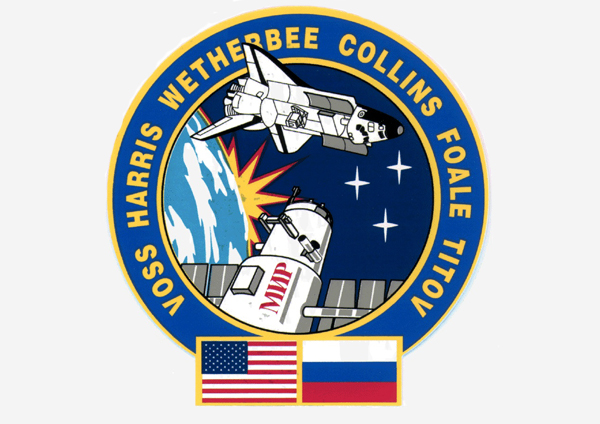
STS-63
Mission: SPACEHAB-3
Space Shuttle: Discovery
Launch Pad: 39B
Launched: February 3, 1995, 12:22:04 a.m. EST
Landing Site: Kennedy Space Center, Florida
Landing: February 11, 1995, 6:50:19 a.m. EST
Mission Duration: 8 days, 6 hours, 28 minutes, 15 seconds
Orbit Altitude: 213 nautical miles
Orbit Inclination: 51.6 degrees
First shuttle flight of 1995 included several history-making achievements: First flight of a female shuttle pilot (Collins) and, as part of Phase I of International Space Station Program, second flight of Russian cosmonaut on shuttle and first approach and flyaround by shuttle with Russian space station Mir.
Crew also worked extensively with payloads aboard Discovery. Flying in forward payload bay and activated on flight day one was SPACEHAB-3. The commercially-developed module was making its third flight on the shuttle and carried 20 experiments: 11 biotechnology experiments; three advanced materials development experiments; four technology demonstrations; and two pieces of supporting hardware measuring on-orbit accelerations. Improvements made to SPACEHAB system to reduce demand on crew time. New video switch added to lessen need for astronaut involvement in video operations, and experiment interface added to telemetry system to allow experiment investigator to link directly via computer with onboard experiment to receive data and monitor status. Charlotte, an experimental robotic device being flown for first time, also will reduce crew workload by taking over simple tasks such as changing experiment samples.
Crew consisted of Commander James D. Wetherbee, Pilot Eileen M. Collins, Missions Specialists C. Michael Foale, Janice E. Voss, Bernard A. Harris, Jr. and Vladimar G. Titov.
For more space shuttle missions, please see:
Join our Space Forums to keep talking space on the latest missions, night sky and more! And if you have a news tip, correction or comment, let us know at: community@space.com.

Space.com is the premier source of space exploration, innovation and astronomy news, chronicling (and celebrating) humanity's ongoing expansion across the final frontier. Originally founded in 1999, Space.com is, and always has been, the passion of writers and editors who are space fans and also trained journalists. Our current news team consists of Editor-in-Chief Tariq Malik; Editor Hanneke Weitering, Senior Space Writer Mike Wall; Senior Writer Meghan Bartels; Senior Writer Chelsea Gohd, Senior Writer Tereza Pultarova and Staff Writer Alexander Cox, focusing on e-commerce. Senior Producer Steve Spaleta oversees our space videos, with Diana Whitcroft as our Social Media Editor.
